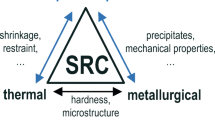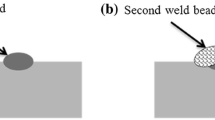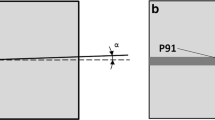Abstract
Martensitic 9–12% chromium steels are favoured grades for thick-walled components in ultra super-critically-operated thermal power plants. Welding in all its variations is the major joining and repair technology for such components. Several years of in-service experience and long-term creep testing data of cross-welds of various martensitic steel grades have revealed the inter-critical or fine-grained region of the heat-affected zone as the weakest part of such welded constructions. Within this work, based on long-term creep tests of cross-weld specimens, the predominant failure mode of Type IV cracking is described. Reduced creep strength of cross-welds is related to an enhanced microstructural degradation in the heat-affected zone. Therefore, the formation of the heat-affected zone and resulting microstructure is investigated using advanced microscopy, physical weld simulation and X-ray diffraction. Phase transformations occurring during characteristic weld thermal cycles in the heat-affected zone are recorded by in-situ X-ray diffraction using high-energy synchrotron radiation. The evolution of microstructure in the heat-affected zone is studied by physical weld simulation and subsequent metallographic examination. Within this work, a novel 9Cr-3-W-3Co steel with balanced additions of boron and nitrogen is produced and investigated. The base material shows superior creep strength at650°C up to the current maximum testing time of 19 000 h. Additionally, the new steel has high potential to overcome Type IV failures by the suppression of grain refinement in the heat-affected zone.
Similar content being viewed by others
References
Abe F. Kern T.U., Viswanathan R.: Creep resistant steels, Woodhead Publishing, 2008.
Cerjak H., Mayr P.: Creep strength of welded joints of ferritic steels, in Abe F. Kern T.U. and Viswanathan R.: Creep resistant steels, Woodhead Publishing, 2008, pp. 472–503.
Francis J.A., Mazur W., Bhadeshia HKDH: Type IV cracking in ferritic power plant steels, Material Science and Technology, 2006, Vol. 22, No. 12, pp. 1387–1395.
Middleton C.J., Metcalfe E.: A review of laboratory Type IV cracking data in high chromium ferritic steels, International Conference Steam Plants for the 1990’s, London, Imeche, 1990.
Ellis F.V., Viswanathan R.: Review of Type IV cracking in piping welds, International Conference on Integrity of High Temperature Welds, London, IOM, 1998.
Brett S.J.: Cracking experience in steam pipework welds in National Power, VGB Conference — Materials and Welding Technology in Power Plants 1994, Essen, VGB, 1994.
Gooch D.J., Kimmins S.T.: Type IV cracking in 1/2Cr1/2Mo1/4V — 2 1/4Cr1 Mo weldments, 3rd International Conference Creep and Fracture of Engineering Materials and Structures, Swansea, Maney Publishing, 1987.
Smith D.J., Walker N.S., Kimmins S.T.: Type IV creep cavity accumulation and failure in steel welds, International Journal of Pressure Vessels and Piping, 2003, vol. 80, no. 9, pp. 617–27.
Brear J.M., Fairman A., Middleton C.J., Polding L.: Predicting the creep life and failure location of weldments, Key Engineering Materials, 2000, vol. 171–174, pp. 35–42.
Fujibayashi S., Endo T.: Creep behaviour of a low alloy ferritic steel weldment, 9th International Conference Creep and Fracture of Engineering Materials and Structures, Cambridge, Maney Publishing, 2001.
Brühl F., Cerjak H., Schwaab P., Weber H.: Metallurgical investigation on the base material and weldments of the 9% chromium X10CrMoVNb91, Steel Research, 1991, Vol. 62, No. 2, pp. 75–82.
Parker J.D., Stratford G.C.: Strain localisation in creep testing of samples with heterogeneous microstructures, International Journal of Pressure Vessels and Piping, 1996, Vol. 68, No. 2, pp. 135–143.
Tezuka H., Sakurai T.: A trigger of Type IV damage and a new heat treatment procedure to suppress it, Microstructural investigations of long-term ex-service Cr-Mo steel pipe elbows, International Journal of Pressure Vessels and Piping, 2005, Vol. 82, No. 3, pp. 165–174.
Shibli I.A., Le Mat Hamata N.: Creep and fatigue crack growth in P91 weldments, 9th International Conference on Creep and Fracture of Engineering Materials and Structures, Cambridge, Woodhead Publishing, 2001.
Ennis P.J.: The mechanical properties and microstructures of 9% chromium steel P92 weldments, OMMI, 2002, Vol. 1, No. 2, pp. 1–23.
Laha K., Chandravathi K.S., Parameswaran P., Bhanu Sankara Rao K.: Type IV cracking susceptibility in weld joints of different grades of Cr-Mo ferritic steel, Metallurgical and Materials Transactions A, 2009, vol. 40A, no. 2, pp. 386–397.
Takemasa F., Nonaka I., Ito T., Saitou K., Miyachi Y., Kagiya Y.I.: Type IV creep damage analysis for full size component test on welded P91 boiler hot reheat piping, International Conference Elevated Temperature Design and Analysis, Nonlinear Analysis and Plastic Components, San Diego, ASME, 2004.
Kondo M., Tabuchi M., Tsukamoto S., Yin F., Abe F.: Suppressing Type IV failure via modification of heat affected zone microstructures using high boron content in 9Cr heat resistant steel welded joints, Science and Technology of Welding and Joining, 2006, Vol. 11, No. 2, pp. 216–223.
Abe F.: Metallurgy for long-term stabilization of ferritic steels for thick section boiler components in USC power plant at 650 °C, 8th International Conference on Materials for Advanced Power Engineering 2006, Liege, Forschungszentrum Jülich, 2006.
Mayr P., Palmer T. A., Elmer J.W., Specht E.D.: Direct observation of phase transformations in the simulated heat-affected zone of a 9Cr martensitic steel, International Journal of Materials Research, 2008, Vol. 99, No. 4, pp. 381–387.
Mayr P.: Weldability of modern 9%Cr steels for application in USC power plants, Doctoral Thesis, Graz University of Technology, 2007.
Mayr P., Cerjak H., Jochum C., Pasternak J.: Longterm creep behaviour of P911 heat resistant 9%Cr steel weldments fabricated with filler metals of different creep strength, ASME 2007 Pressure Vessels and Piping Conference and Eigth International Conference on Creep and Fatigue at Elevated Temperatures, 2007.
Sakuraya K., Okada H., Abe F.: Coarse size BN Type inclusions formed in boron bearing high Cr ferritic heat resistant steel, 4th International Conference on Advances in Materials Technology for Fossil Power Plants, Hilton Head Island, SC, EPRI, 2004.
Abe F.: Alloy design of creep and oxidation resistant 9Cr steels for thick section boiler components operating at 650°C, 4th International Conference on Advances in Materials Technology for Fossil Power Plants, Hilton Head Island, SC, EPRI, 2004.
Datasheet Thermanit MTS 911, Böhler Thyssen Schweisstechnik Deutschland GmbH, Edition 09/2005.
Böhler Welding Guide, Technical Handbook of BÖHLER WELDING Products, Edition 01/2008.
Holzer I., Kozeschnik E.: Precipitation during heat treatment and service — Characterisation, simulation and strength contribution, in Abe F. Kern T.U. and Viswanathan R.: Creep resistant steels, Woodhead Publishing, 2008, pp. 305–328.
Elmer J.W., Palmer T.A., Babu S.S., Specht E.D.: In situ observations of lattice expansion and transformation rates of α and β phases in Ti-6Al-4V, Materials Science and Engineering A, 2005, vol. 391, no. 1–2.
ECCC Creep Datasheets 2005, Steel P911 (X11 Cr-MoWVNb9-1–1, European Creep Collaborative Committee, 2005.
Danielsen H.K., Hald J.: Behaviour of Z phase in 9–12%Cr steels, Energy Materials, 2006, Vol. 1, No. 1, pp. 49–57.
Kimmins S.T., Gooch D.J.: Austenite memory effect in 1Cr-1Mo-0.75V (Ti, B) steel, Metal Science, 1983, Vol. 17, No. 11, pp. 519–532.
Nakada N., Tsuchiyama T., Takaki S., Hashizume S.: Variant selection of reversed austenite in lath martensite, ISIJ International, 2007, Vol. 47, No. 10, pp. 1527–1532.
ECCC Creep Datasheets 2005, Steel ASTM Grade 92, European Creep Collaborative Committee, 2005.
VdTÜV Datasheet X10CrMoVNb9–1, 1.4903, Verband der technischen Überwachungs-Vereine e.V., VdTÜV, 12/2004.
Author information
Authors and Affiliations
Corresponding author
Rights and permissions
About this article
Cite this article
Mayr, P. Henry Granjon Prize Competition 2008 Joint Winner — Category B: “Materials Behaviour and Weldability” Evolution of Microstructure and Mechanical Properties of the Heat-Affected Zone in 9Cr Steels. Weld World 54, R1–R11 (2010). https://doi.org/10.1007/BF03263479
Published:
Issue Date:
DOI: https://doi.org/10.1007/BF03263479




